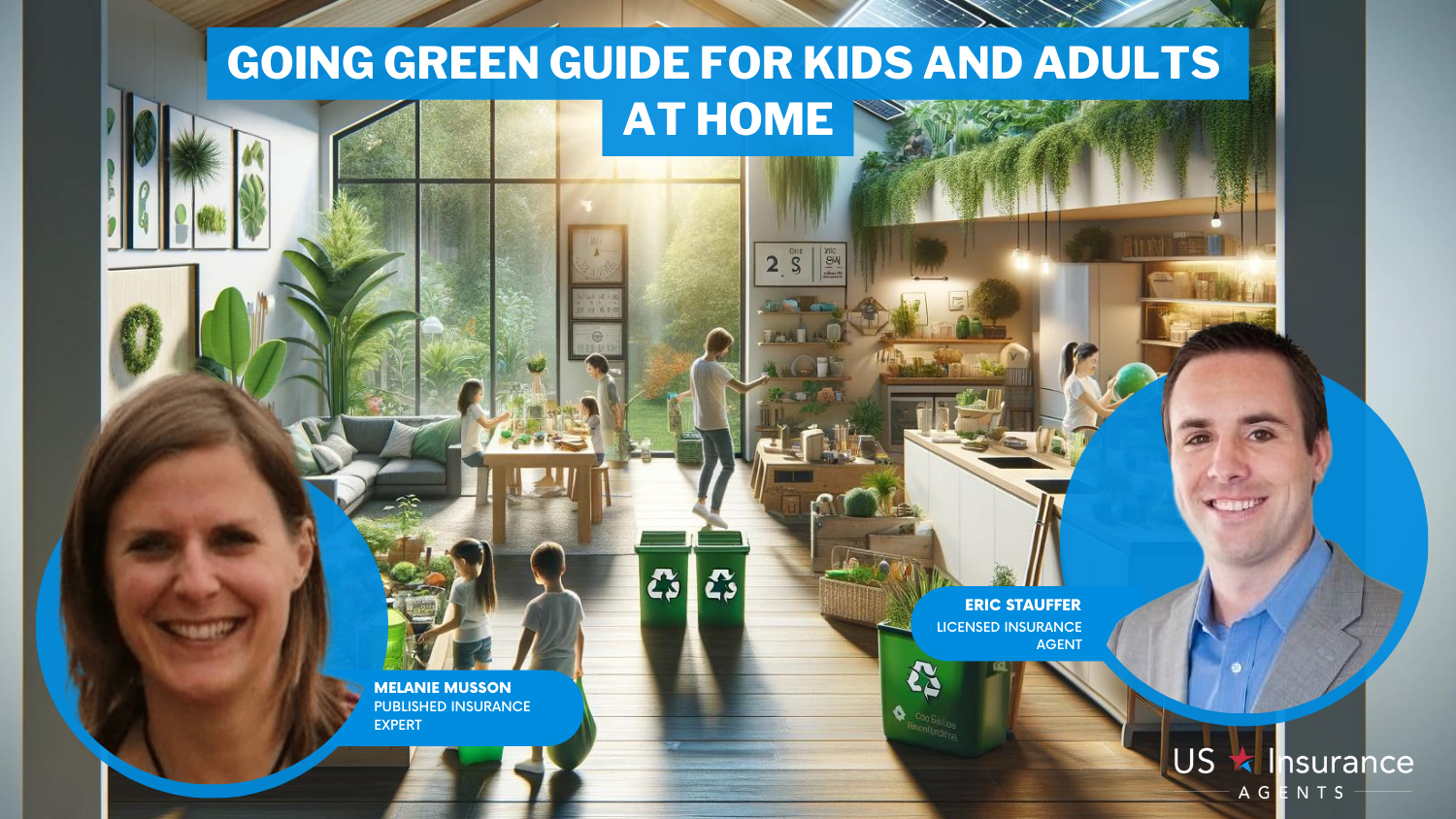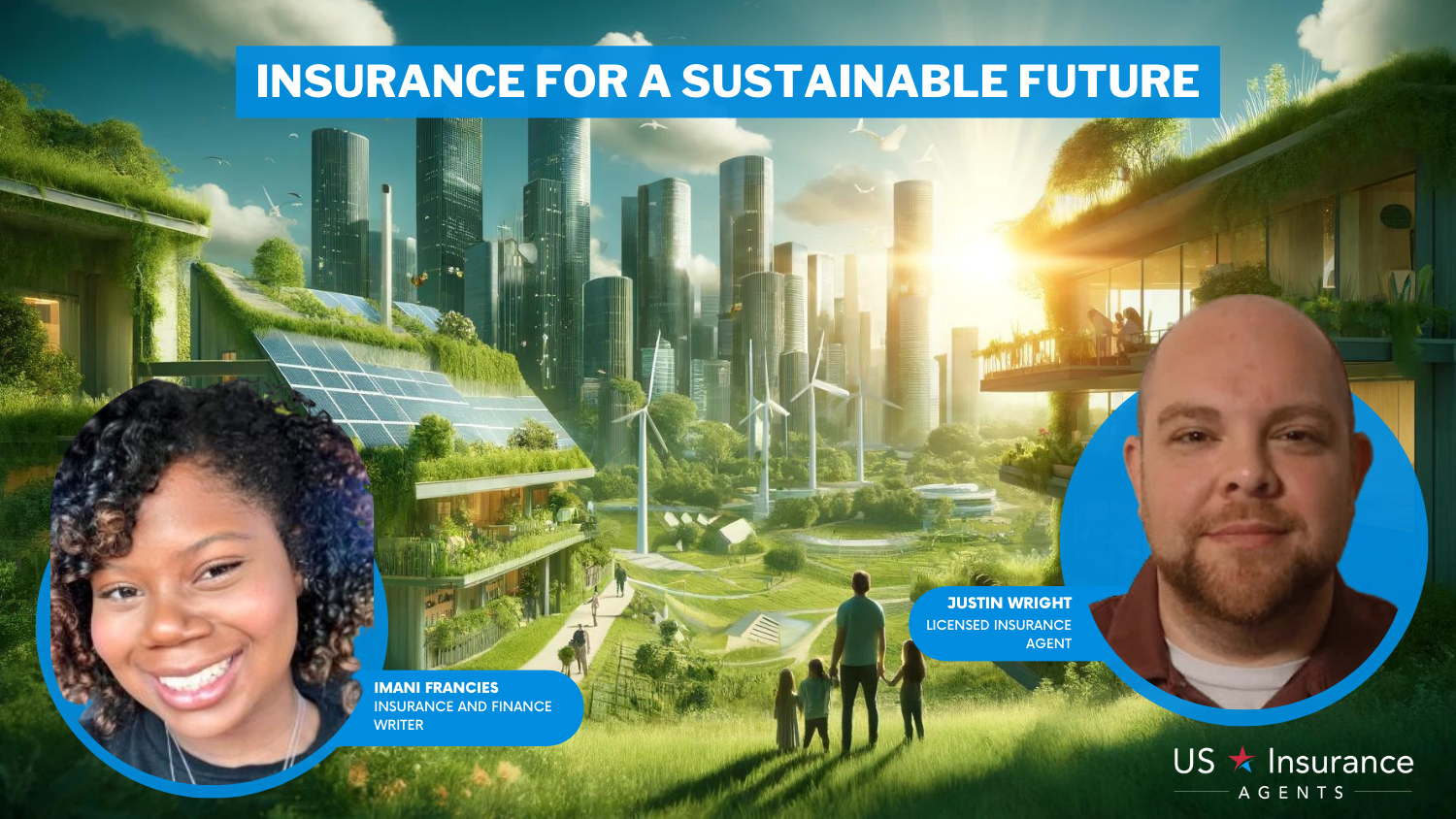Going Green Guide for Kids and Adults at Home – Assurance for a Healthy Earth
Embrace sustainability at home with the comprehensive Going Green Guide for kids and adults. Discover practical tips, valuable information, and actionable steps to ensure a healthy earth and a brighter future for generations to come. From energy conservation to waste reduction, this guide covers a wide range of eco-friendly practices that you can easily implement in your daily life.
Read more Secured with SHA-256 Encryption





Table of Contents
Table of Contents


Published Insurance Expert
Melanie Musson is the fourth generation in her family to work in the insurance industry. She grew up with insurance talk as part of her everyday conversation and has studied to gain an in-depth knowledge of state-specific insurance laws and dynamics as well as a broad understanding of how insurance fits into every person’s life, from budgets to coverage levels. Through her years working in th...
Melanie Musson


Sr. Director of Content
Sara Routhier, Senior Director of Content, has professional experience as an educator, SEO specialist, and content marketer. She has over 10 years of experience in the insurance industry. As a researcher, data nerd, writer, and editor, she strives to curate educational, enlightening articles that provide you with the must-know facts and best-kept secrets within the overwhelming world of insurance....
Sara Routhier


Licensed Insurance Agent
Eric Stauffer is an insurance agent and banker-turned-consumer advocate. His priority is educating individuals and families about the different types of insurance coverage. He is passionate about helping consumers find the best coverage for their budgets and personal needs. Eric is the CEO of C Street Media, a full-service marketing firm and the co-founder of ProperCents.com, a financial educat...
Eric Stauffer
Updated October 2024
Welcome to our comprehensive guide, “Going Green Guide for Kids and Adults at Home – Assurance for a Healthy Earth.”

Discover practical tips and strategies to create a sustainable home environment. From energy conservation to waste reduction, we cover key topics that empower you to make a positive impact on the planet.
Enter your zip code below to compare rates from the best insurance providers and secure coverage that aligns with your eco-friendly lifestyle. Start your journey towards a greener future today.
Basics of Recycling

Consumers add to a significant portion of waste. According to the Center for Sustainability and Commerce at Duke University, 220 million tons of waste ends up in United States landfills each year. We can just as easily add to a greener world instead by making some simple changes at home.
Recycling is a circular process that is meant to keep material within the consumer and industrial loop without wasting it. What does that mean? If we recycle instead of throwing things away, then we can reuse our limited resources instead of taking them from already strained and dwindling sources.
By making changes in how we use and dispose of products, we reduce the carbon footprint of many general manufacturing processes, and fewer raw materials are needed to create the products that we use every day.
Know your numbers!
In the United States, most containers will have a recycling symbol on the label with a number between one and seven to assist in this process. These numbers indicate what can and cannot be recycled according to the local recycling center’s policies. Seven is mixed plastics, and is never recyclable.
Tips for simple recycling
- Labels should be stripped from tin cans.
- Tape a list of items that can be recycled onto the refrigerator door.
Getting the kids involved
- Keep colorful recycling bins in the kitchen and get the kids involved in labeling them for plastic, paper, metal and other recycling as indicated by your local recycling and waste management agency (formerly known as the dump!). Making recycling simple and the bins easy to recognize will help to get the whole family recycling in no time.
- Offer rewards for good recycling habits and keep a chart of who recycles the most each day.
For more information, the United States Environmental Protection Agency offers advice on what to do with all of your recyclables:
- Recycling basics by the US Environmental Protection agency: https://www.epa.gov/circulareconomy/us-recycling-system
- Advice about recycling from the LA Department of Public Works: https://dpw.lacounty.gov/epd/drp/recyclingtips.cfm
- Detailed reducing, reusing, and recycling resources from Columbia University: https://research.columbia.edu/environmental-health-safety-ehs
- Recycling tips from Fairfax County Virginia: https://www.fairfaxcounty.gov/soil-water-conservation/
Free Home Insurance Comparison
Compare Quotes From Top Companies and Save
Secured with SHA-256 Encryption
Food Choices
What you eat can affect both you and the environment. Having healthy food choices available in the kitchen does more than help to save the environment – it can save family members from preventable conditions such as type 2 diabetes and heart disease.
Shop and Eat Locally!
Food from nearby is better for the environment because it takes less energy to transport to your kitchen table. According to World Watch, the average meal has traveled 1,500 miles before reaching your plate. That is a lot of oil consumed and much of it could have been prevented through finding and sourcing foods locally.
Tips for eating locally
- Buy in season. If you live in a moderate to cold climate, chances are any oranges purchased in February are not going to be from within your state! Find out what grows in your climate and what time of year foods are harvested there.
- Look for “locally grown” signs and packaging. Many farms and producers are happy to advertise that they are from the area.
- Check the label. You can often find the state or country origin of a product by looking at the label or on the back of the packaging.
Getting the kids involved
Find your local farmer’s market and make it a fun day out with the family. Famer’s markets are a great source of truly local vegetables in addition to being a good place to meet your neighbors, support local farmers, and spend time in the community.
More Greens for a Greener Planet
Where our meal is on the food chain can make a difference when it comes to the environment. A diet high in vegetables and lower in meat can improve not only your family’s health, but it can also help to improve how land and resources are used.
Animals have consumed many times their weight before they reach maturity. In addition, they can produce harmful methane, making larger animals, such as cows, particularly dangerous for the environment. A diet based more on foods that grow from the ground will put a much smaller stress on both the infrastructure it came from and the world around it.
- To learn more about how our food choices affect the environment, see the Natural Resource Defense Council’s Eat Green guide: https://www.nrdc.org/stories/how-you-can-stop-global-warming
- Simple Steps offers a great tool for finding local foods in your area: http://www.simplesteps.org/eat-local
- To learn how far your food travels, visit World Watch: http://www.worldwatch.org/globetrotting-food-will-travel-farther-ever-thanksgiving
Water Conservation
Water consumption has a drastic effect on the environment due to the distance that water travels before it reaches the tap at home. Remembering to save water can save an immense amount of energy. That energy would have been needed to clean and transport the excess water through underground channels that require more maintenance the more they are used.
Conserving water also decreases the load on a city’s water treatment plants, making it less likely that they will spill over and pollute local water sources during storms and times of excess use.
Tips for conserving water at home
- Use the environmental setting on both dishwashers and washing machines.
- Reuse cups and glasses, as appropriate, rather than dirtying a new one each time you need a drink.
- Plug the sink and bathtub drains before turning on the water.
- Wash pans in a bucket of soapy water rather than under a running tap.
- Collect rainwater for plants.
- Grow a garden that is drought resistant and that requires less water.
- Check your water bill. If it is high, there might be a leak.
- Switch to water saving showerheads and install a low flow toilet the next time the bathroom needs remodeling.
Getting the kids involved
- Give children their own unique cups to reuse throughout the day.
- Remind kids to turn off the water while they are brushing their teeth and to turn it on only when it is needed.
For more tips and ideas, visit these resources:
- Save Our Water has a lot of elpful articles and interactive graphics to help learn about water conservation: http://saveourwater.com/what-you-can-do/tips/
- For more than a hundred ideas on how to conserve water at home, visit: https://wateruseitwisely.com/100-ways-to-conserve-water/
Energy Conservation
Saving energy is an efficient way to keep the environment clean. Many utility companies still rely on problematic and polluting sources of electrify. A simple flick of a switch can save large quantities of non-renewable fuels from being used and lost forever.
Tips
- Use energy saving light bulbs and replace any remaining less energy efficient incandescent bulbs.
- Turn down the heater by a few degrees in the winter and make plans to use less air conditioning in summer months.
- Make meals that require less cooking time.
- Plug in “always on” electronic devices into power strips and turn off the strips with just a flick of a switch before leaving the house or going to bed. This will help to prevent stand-by drain.
- Windows, vents, doors, and the roof can be insulated to keep the heat in when the temperatures drop.
- Use machines with an EnergyStar rating to save additional electricity.
- Consider installing solar panels.
Getting the kids involved
- Teach children to turn off lights before leaving a room. Put friendly stickers near light switches to remind them.
- Find games and activities to do as a family that don’t require screen time.
- Go out for a family bike ride or walk.
For more reasons and ways to save energy, visit Energy.gov and the NDRC:
- Energy saving guide: https://www.energy.gov/energysaver/energy-saver-guide-tips-saving-money-and-energy-home
- Energy Conservation Guidelines (PDF): http://www.pittstate.edu/office/president/initiatives/sustainability/documents/PSU-Energy-Conservati
- Resources to help you green your home and make better environmental decisions: https://guides.library.illinois.edu/c.php?g=347680&p=2349793
Free Home Insurance Comparison
Compare Quotes From Top Companies and Save
Secured with SHA-256 Encryption
Composting
Composting is a great way not only to help take up less space in our landfills, but also to beautify the garden at home. When done with care, food waste can become an excellent source of plant food for flowers, vegetables, trees and the lawn. This also helps to reduce the amount of chemicals needed to maintain a garden and thus limits potential ground water contamination.
Simple backyard composting is an accelerated version of nature’s process of decay. The compost is kept exposed to the air and is mixed carefully with other vegetation under a protective tarp or in a designated container. This process created chemical reactions that break the food down in a safer and faster manner than what would happen in a landfill. The healthy aerobic bacteria and decomposers that thrive from the process even replace the production of methane, a major greenhouse gas, in favor of carbon dioxide, a colorless and odorless gas that plants thrive on and that is vital to survival on our planet.
Read more: Best Business Insurance for Greenhouses
Composting tips
- Have a separate sealed container for food waste and empty it just as frequently as you would do with ordinary waste.
- If you have room, set up a space in the yard that is dedicated to composting.
Getting the kids involved
- Teach everyone in the family to scrape their plate into your food waste container after a meal.
- Get the kids involved in and learning about gardening. Worms, flowers and soil can all become an interesting lesson in science.
For more information, check out these helpful sites:
- For more information on composting, the United States Environmental Protection Agency offers advice on composting options that can be done at home: https://www.epa.gov/recycle/composting-home
- For frequently asked questions and detailed terminology, see the Cornell Waste Management Institute’s site:http://cwmi.css.cornell.edu/resources.htm#composting
- Detailed guide on backyard composting: https://extension.umd.edu/sites/default/files/_images/programs/hgic/Publications/HG35_Backyard_Compo
- The Environmental Education for Kids (EEK!) has kid friendly information about composting with worms: https://eekwi.org/earth/recycle/compost2.htm
Cleaning Supplies
Cleaning chemicals, while making the house sparkle, can be harmful to the atmosphere, humans, pets, and the soil quality of the surrounding environment. Thankfully, not all cleaners are equally as toxic and there are still ways to keep a spotless home without sacrificing the environment or the family’s health.
Products to use
- Approved cleaners that have been tested and are within environmental risk limits have labels that indicate BioPreferred, Safer Choice, and Green Seal. Check the label!
- To go a step further and avoid environmental effects altogether, consider going green by using natural cleaners. Vinegar, baking soda, and lemon juice all have their place in everyday cleaning and they carry various disinfectant and stain-lifting properties without the health or environmental risks of chemical cleaners.
- For a complete list of eco labels, visit the Ecolabel Index: https://www.ecolabelindex.com/ecolabels/
- For natural alternatives to traditional cleaning chemicals, visit Xavier University: http://www.xavier.edu/green/Clean-and-Green.cfm
Donating vs. Throwing Away
What cannot be recycled might just be something that would be better off in different hands. Finding a new home for household goods and clothing can help to lower the overall demand for the manufacturing of new replacement products.
How to re-home your unwanted items
- Various charities and thrift stores accept donations of gently used clothes and goods.
- Have a yard sale and earn some money while helping out the environment and giving someone a good deal on items they might have had to buy new otherwise.
- Sell or give away your items through local online services such as Craigslist (http://craigslist.org) and Freecycle (http://freecycle.org).
Getting the kids involved
Have older children go through their old clothes and toys to decide which ones they no long use and which ones are in good enough condition to sell or give away.
Free Home Insurance Comparison
Compare Quotes From Top Companies and Save
Secured with SHA-256 Encryption
Additional Resources
For more tips and advice:
- New York’s Department of Environmental Conservation offers some great advice on reducing waste: https://www.dec.ny.gov/chemical/8828.html
- Here are some tips from CalRecycle on what can be recycled:http://www.calrecycle.ca.gov/publiced/earthday/what.htm
- The United States Department of Agriculture discusses reducing food waste: http://www.usda.gov/oce/foodwaste/faqs.htm
- The National Institute of Environmental Health Sciences suggests ways that kids can reduce waste:http://kids.niehs.nih.gov/explore/reduce/reduce_waste.htm
- University of Buffalo offers electrify saving advice for the home:http://www.buffalo.edu/youhavethepower/yhtp.html
- The Tennessee Valley Authority highlights ways that kids can help to save electricity: https://www.tvakids.org/electricity/conservation.htm
- Kids Be Green offers fun and interactive green-living learning tools for kids: http://www.kidsbegreen.org/

Frequently Asked Questions
What is a going green guide?
A going green guide is a set of tips, tricks, and best practices for reducing one’s carbon footprint and promoting sustainable living.
Why is it important to go green?
Going green helps to reduce the impact of human activity on the environment, including reducing greenhouse gas emissions, preserving natural resources, and protecting biodiversity.
What are some easy ways to go green at home?
Some easy ways to go green at home include using energy-efficient appliances, reducing water usage, composting, recycling, using reusable bags and containers, and using non-toxic cleaning products.
How can kids get involved in going green?
Kids can get involved in going green by starting a school or community garden, participating in recycling programs, using reusable water bottles and lunch containers, and learning about environmental issues through books and documentaries.
How can going green impact insurance rates?
Some insurance companies offer discounts for environmentally-friendly practices such as driving a hybrid or electric vehicle, using energy-efficient appliances, and installing energy-saving home improvements. Additionally, reducing your carbon footprint can lower the risk of damage from natural disasters, which may impact insurance rates.
Get a FREE Quote in Minutes
Insurance rates change constantly — we help you stay ahead by making it easy to compare top options and save.






